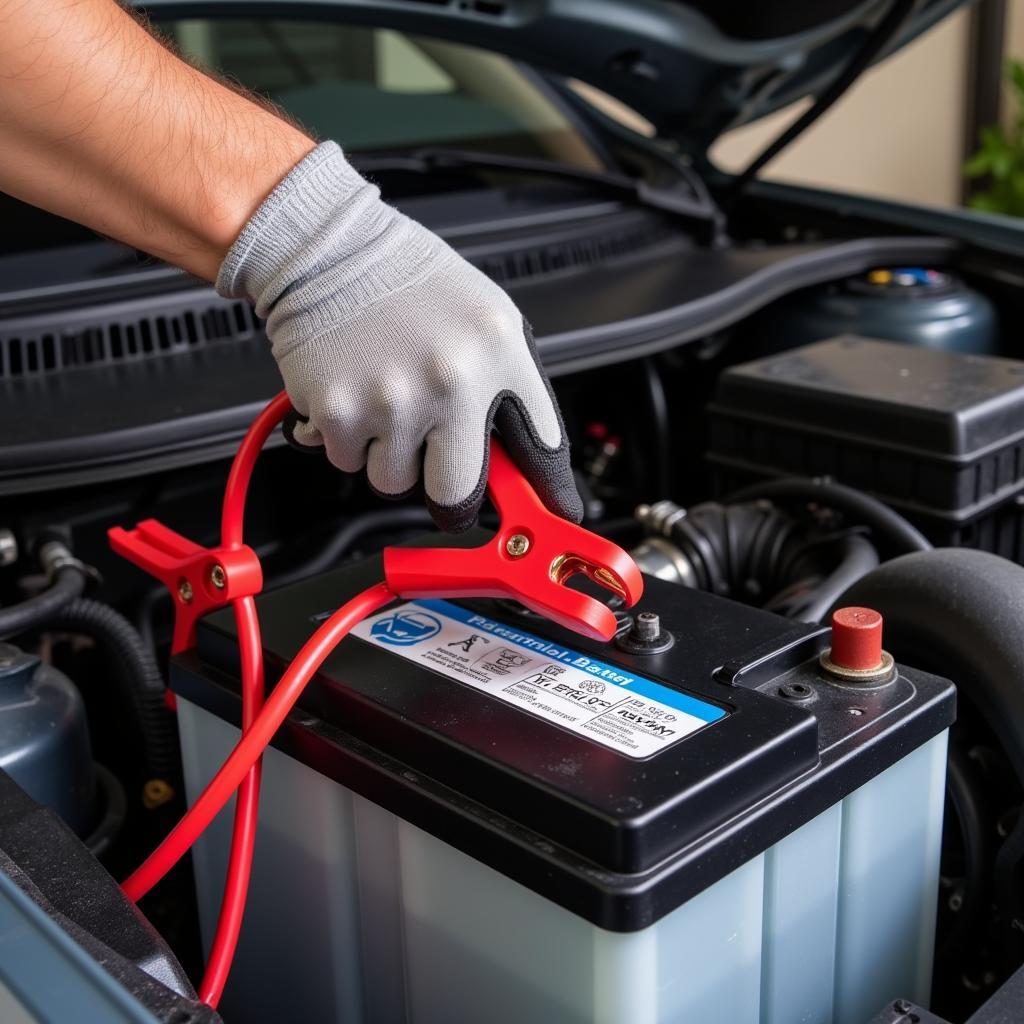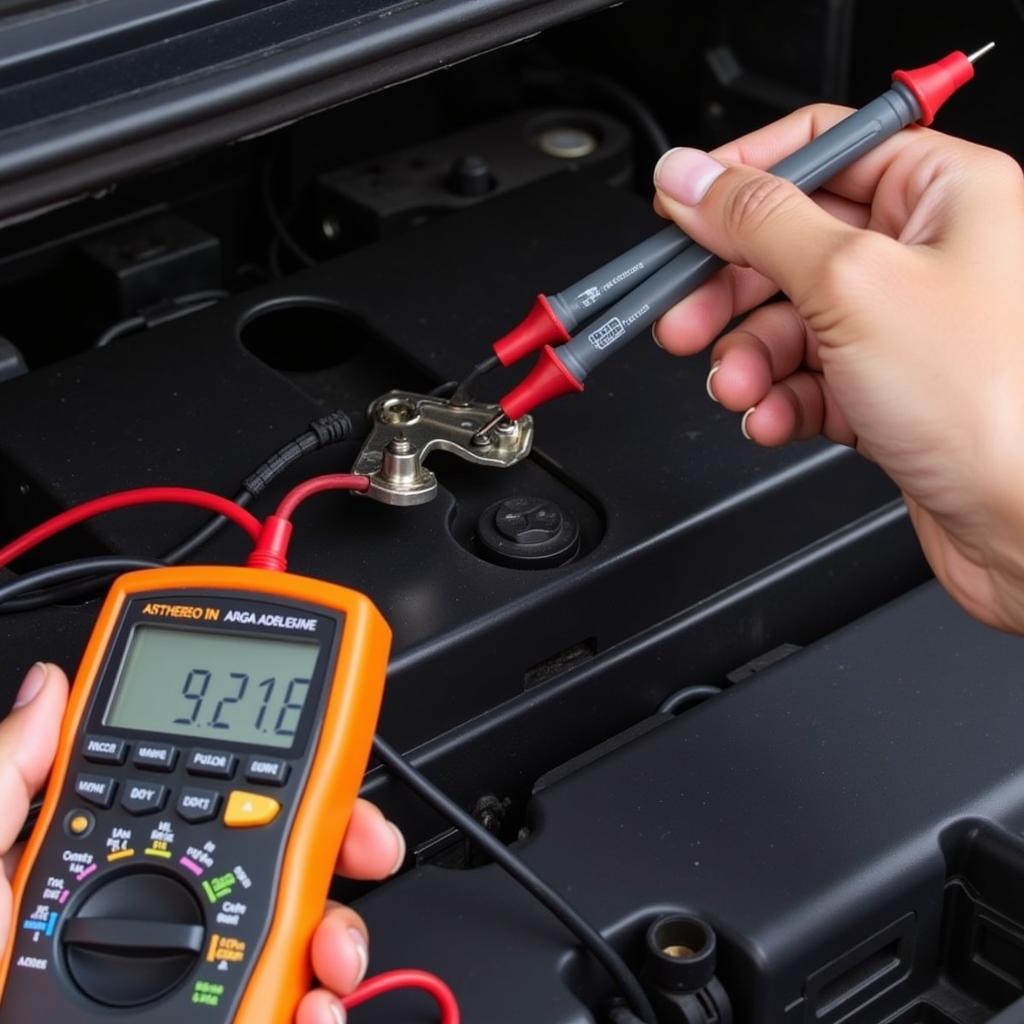Car battery problems can leave you stranded and frustrated. Whether it’s a slow crank, dim headlights, or a complete no-start, troubleshooting these issues quickly is essential. This guide provides expert advice on diagnosing, fixing, and even preventing common car battery woes. We’ll cover everything from simple checks to more advanced solutions, empowering you to get back on the road with confidence. After reading this, you’ll be well-equipped to handle most car battery problems yourself.
 Jump Starting a Car Battery with Jumper Cables
Jump Starting a Car Battery with Jumper Cables
Common Signs of Car Battery Problems
A failing car battery often shows warning signs before completely dying. Recognizing these signs can save you from unexpected breakdowns. Some common indicators include:
- Slow Cranking: The engine cranks slowly or struggles to turn over.
- Dim Headlights: Headlights appear dimmer than usual, especially when the engine is idling.
- Clicking Sound When Starting: A rapid clicking sound when you turn the key indicates a low battery.
- Interior Lights Malfunctioning: Interior lights may be dim or flicker.
- Dashboard Warning Lights: Check engine light or battery light illuminated.
- Swollen Battery Case: A bloated or cracked battery case signifies internal damage.
- Old Age: Batteries typically last 3-5 years. Age alone can be a factor.
If you notice any of these symptoms, it’s time to start troubleshooting.
 Testing a Car Battery with a Multimeter
Testing a Car Battery with a Multimeter
DIY Car Battery Troubleshooting Steps
Here’s a step-by-step guide to help you troubleshoot your car battery problems:
- Check the Terminals: Inspect the battery terminals for corrosion. Clean them with a wire brush and baking soda solution if necessary.
- Test the Voltage: Use a multimeter to check battery drain with multimeter. A fully charged battery should read around 12.6 volts.
- Inspect the Cables: Ensure the battery cables are securely connected and free of damage.
- Try Jump Starting: If the battery is low, jump-start the car using jumper cables and another vehicle. If the car starts, your battery is likely the culprit.
- Check the Alternator: A faulty alternator can prevent the battery from charging properly. Have it tested by a mechanic.
“Many drivers overlook the simple step of cleaning battery terminals. Corrosion can significantly impact battery performance,” says automotive expert, John Miller, ASE Certified Master Technician.
Advanced Troubleshooting and Solutions
Sometimes, basic troubleshooting isn’t enough. Here are some advanced techniques and solutions:
- Parasitic Draw Test: This test identifies any electrical components draining the battery while the car is off.
- Battery Load Test: A load test measures the battery’s ability to hold a charge under load. A professional mechanic can perform this test.
- Battery Replacement: If the battery is old or fails testing, it’s time for a new one.
- Alternator Replacement: A faulty alternator will require replacement.
- Electrical System Diagnosis: If none of the above solutions work, a thorough electrical system diagnosis is necessary to pinpoint the problem. This may involve checking fuses, relays, and wiring.
Preventing Future Car Battery Issues
Proactive maintenance can extend your battery’s life and prevent future problems:
- Regular Cleaning: Keep the battery terminals clean and free of corrosion.
- Limit Short Trips: Short trips prevent the alternator from fully charging the battery.
- Turn Off Accessories: Ensure headlights, radio, and other accessories are off when the car is not running.
- Regular Battery Testing: Test your battery voltage every few months, especially during extreme temperatures.
- Proper Storage: If storing your vehicle for an extended period, consider disconnecting the battery or using a battery maintainer.
Conclusion
Troubleshooting car battery problems can seem daunting, but with the right knowledge and tools, it’s manageable. By following the steps outlined in this guide, you can diagnose and fix many common issues yourself. Remember, regular maintenance is key to a healthy car battery and a smooth driving experience. If you are still experiencing problems after trying these troubleshooting tips, consider seeking professional help from a qualified mechanic. Don’t forget to check out our articles about gmc acadia key fob battery, bluetooth radio fm transmitter for car, or even 2014 chrysler 200 battery problems and does the nissan kicks come with an anti theft device for more specialized car information.
FAQ (Frequently Asked Questions)
- How long does a car battery typically last?
A car battery usually lasts 3-5 years. - Can I jump-start my car with any other car?
It’s best to use a car with a similar battery voltage. - What causes a car battery to drain quickly?
Several factors, including a faulty alternator, parasitic draw, or leaving lights on. - How often should I clean my battery terminals?
Clean them every few months or as needed if you see corrosion. - Is it safe to jump-start a car?
Yes, as long as you follow the proper procedures and safety precautions. - What are signs of a bad alternator?
Dimming lights, a whining noise from the engine, and a dead battery. - How much does a new car battery cost?
The price varies depending on the type and brand but typically ranges from $50 to $200.

